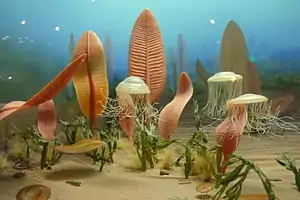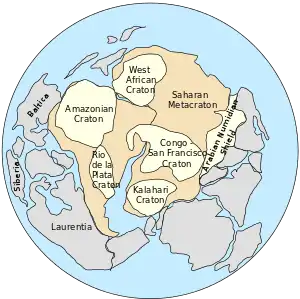Proterozoic
The Proterozoic ( /ˌproʊtərəˈzoʊɪk, prɒt-, -əroʊ-, -trə-, -troʊ-/)[2][3][4] is a geological eon spanning the time from the appearance of oxygen in Earth's atmosphere to just before the proliferation of complex life (such as trilobites or corals) on the Earth. The name Proterozoic combines the two forms of ultimately Greek origin: protero- meaning "former, earlier", and -zoic, a suffix related to zoe "life". The Proterozoic Eon extended from 2500 mya to 541 mya (million years ago), and is the most recent part of the Precambrian "supereon." The Proterozoic is the longest eon of the Earth's geologic time scale and it is subdivided into three geologic eras (from oldest to youngest): the Paleoproterozoic, Mesoproterozoic, and Neoproterozoic.[5]
| Proterozoic | |
|---|---|
| 2500 – 541.0 ± 1.0 Ma | |
 Artist's depiction of life on the ocean floor as it may have appeared in the late Proterozoic.[1] | |
| Chronology | |
-4500 — – -4000 — – -3500 — – -3000 — – -2500 — – -2000 — – -1500 — – -1000 — – -500 — – 0 — | |
| Etymology | |
| Name formality | Formal |
| Usage information | |
| Celestial body | Earth |
| Regional usage | Global (ICS) |
| Time scale(s) used | ICS Time Scale |
| Definition | |
| Chronological unit | Eon |
| Stratigraphic unit | Eonothem |
| Time span formality | Formal |
| Lower boundary definition | Defined Chronometrically |
| Lower boundary GSSP | N/A |
| GSSP ratified | N/A |
| Upper boundary definition | Appearance of the Ichnofossil Treptichnus pedum |
| Upper boundary GSSP | Fortune Head section, Newfoundland, Canada 47.0762°N 55.8310°W |
| GSSP ratified | 1992 |
The well-identified events of this eon were the transition to an oxygenated atmosphere during the Paleoproterozoic; several glaciations, which produced the hypothesized Snowball Earth during the Cryogenian Period in the late Neoproterozoic Era; and the Ediacaran Period (635 to 541 Ma) which is characterized by the evolution of abundant soft-bodied multicellular organisms and provides us with the first obvious fossil evidence of life on earth.
The Proterozoic record
The geologic record of the Proterozoic Eon is more complete than that for the preceding Archean Eon. In contrast to the deep-water deposits of the Archean, the Proterozoic features many strata that were laid down in extensive shallow epicontinental seas; furthermore, many of those rocks are less metamorphosed than there are Archean ones, and many are unaltered.[6]:315 Studies of these rocks have shown that the eon continued the massive continental accretion that had begun late in the Archean Eon. The Proterozoic Eon also featured the first definitive supercontinent cycles and wholly modern mountain building activity (orogeny).[6]:315–18, 329–32
There is evidence that the first known glaciations occurred during the Proterozoic. The first began shortly after the beginning of the Proterozoic Eon, and evidence of at least four during the Neoproterozoic Era at the end of the Proterozoic Eon, possibly climaxing with the hypothesized Snowball Earth of the Sturtian and Marinoan glaciations.[6]:320–1, 325
The accumulation of oxygen
One of the most important events of the Proterozoic was the accumulation of oxygen in the Earth's atmosphere. Though oxygen is believed to have been released by photosynthesis as far back as Archean Eon, it could not build up to any significant degree until mineral sinks of unoxidized sulfur and iron had been exhausted. Until roughly 2.3 billion years ago, oxygen was probably only 1% to 2% of its current level.[6]:323 The Banded iron formations, which provide most of the world's iron ore, are one mark of that mineral sink process. Their accumulation ceased after 1.9 billion years ago, after the iron in the oceans had all been oxidized.[6]:324
Red beds, which are colored by hematite, indicate an increase in atmospheric oxygen 2 billion years ago. Such massive iron oxide formations are not found in older rocks.[6]:324 The oxygen buildup was probably due to two factors: exhaustion of the chemical sinks, and an increase in carbon burial, which sequestered organic compounds that would have otherwise been oxidized by the atmosphere.[6]:325
Subduction processes
The Proterozoic Eon was a very tectonically active period in the Earth's history. The late Archean Eon to Early Proterozoic Eon corresponds to a period of increasing crustal recycling, suggesting subduction. Evidence for this increased subduction activity comes from the abundance of old granites originating mostly after 2.6 Ga.[7] The occurrence of eclogite (a type of metamorphic rock created by high pressure, > 1 GPa), is explained using a model that incorporates subduction. The lack of eclogites that date to the Archean Eon suggests that conditions at that time did not favor the formation of high grade metamorphism and therefore did not achieve the same levels of subduction as was occurring in the Proterozoic Eon.[8] As a result of remelting of basaltic oceanic crust due to subduction, the cores of the first continents grew large enough to withstand the crustal recycling processes.
The long-term tectonic stability of those cratons is why we find continental crust ranging up to a few billion years in age.[9] It is believed that 43% of modern continental crust was formed in the Proterozoic, 39% formed in the Archean, and only 18% in the Phanerozoic.[7] Studies by Condie (2000)[10] and Rino et al. (2004) suggest that crust production happened episodically. By isotopically calculating the ages of Proterozoic granitoids it was determined that there were several episodes of rapid increase in continental crust production. The reason for these pulses is unknown, but they seemed to have decreased in magnitude after every period.[7]
Tectonic history (supercontinents)
Evidence of collision and rifting between continents raises the question as to what exactly were the movements of the Archean cratons composing Proterozoic continents. Paleomagnetic and geochronological dating mechanisms have allowed the deciphering of Precambrian Supereon tectonics. It is known that tectonic processes of the Proterozoic Eon resemble greatly the evidence of tectonic activity, such as orogenic belts or ophiolite complexes, we see today. Hence, most geologists would conclude that the Earth was active at that time. It is also commonly accepted that during the Precambrian, the Earth went through several supercontinent breakup and rebuilding cycles (Wilson cycle).[7]
In the late Proterozoic (most recent), the dominant supercontinent was Rodinia (~1000–750 Ma). It consisted of a series of continents attached to a central craton that forms the core of the North American Continent called Laurentia. An example of an orogeny (mountain building processes) associated with the construction of Rodinia is the Grenville orogeny located in Eastern North America. Rodinia formed after the breakup of the supercontinent Columbia and prior to the assemblage of the supercontinent Gondwana (~500 Ma).[11] The defining orogenic event associated with the formation of Gondwana was the collision of Africa, South America, Antarctica and Australia forming the Pan-African orogeny.[12]
Columbia was dominant in the early-mid Proterozoic and not much is known about continental assemblages before then. There are a few plausible models that explain tectonics of the early Earth prior to the formation of Columbia, but the current most plausible hypothesis is that prior to Columbia, there were only a few independent cratons scattered around the Earth (not necessarily a supercontinent, like Rodinia or Columbia).[7]
Life

The first advanced single-celled, eukaryotes and multi-cellular life, preserved as the Francevillian biota, roughly coincides with the start of the accumulation of free oxygen.[13] This may have been due to an increase in the oxidized nitrates that eukaryotes use, as opposed to cyanobacteria.[6]:325 It was also during the Proterozoic that the first symbiotic relationships between mitochondria (found in nearly all eukaryotes) and chloroplasts (found in plants and some protists only) and their hosts evolved.[6]:321–2
The blossoming of eukaryotes such as acritarchs did not preclude the expansion of cyanobacteria; in fact, stromatolites reached their greatest abundance and diversity during the Proterozoic, peaking roughly 1200 million years ago.[6]:321–3
The earliest fossils possessing features typical of fungi date to the Paleoproterozoic era, some 2,400 million years ago; these multicellular benthic organisms had filamentous structures capable of anastomosis.[14]
Classically, the boundary between the Proterozoic and the Phanerozoic eons was set at the base of the Cambrian Period when the first fossils of animals, including trilobites and archeocyathids, as well as the animal-like Caveasphaera, appeared. In the second half of the 20th century, a number of fossil forms have been found in Proterozoic rocks, but the upper boundary of the Proterozoic has remained fixed at the base of the Cambrian, which is currently placed at 541 Ma.
See also
References
- Smithsonian National Museum flickr.
- "Proterozoic – definition of Proterozoic in English from the Oxford dictionary". OxfordDictionaries.com. Retrieved 2016-01-20.
- "Proterozoic". Merriam-Webster Dictionary.
- "Proterozoic". Dictionary.com Unabridged. Random House.
- Speer, Brian. "The Proterozoic Eon". University of California Museum of Paleontology.
- Stanley, Steven M. (1999). Earth System History. New York: W.H. Freeman and Company. ISBN 978-0-7167-2882-5.
- Kearey, P.; Klepeis, K.; Vine, F. (2008). Precambrian Tectonics and the Supercontinent Cycle. Global Tectonics (Third ed.). pp. 361–377.
- Bird, P. (2003). "An updated digital model of plate boundaries". Geochemistry, Geophysics, Geosystems. 4 (3): 1027. Bibcode:2003GGG.....4.1027B. doi:10.1029/2001GC000252.
- Mengel, F. (1998). Proterozoic History. Earth System: History and Variablility. 2.
- Condie, K. (2000). Episodic continental growth models: afterthoughts and extensions. Tectonophysics, 322(1), 153–162. https://doi.org/10.1016/S0040-1951(00)00061-5
- Condie, K. C.; O'Neill, C. (2011). "The Archean-Proterozoic boundary: 500 my of tectonic transition in Earth history". American Journal of Science. 310 (9): 775–790. Bibcode:2010AmJS..310..775C. doi:10.2475/09.2010.01. S2CID 128469935.
- Huntly, C. (2002). The Mozambique Belt, Eastern Africa: Tectonic evolution of the Mozambique Ocean and Gondwana amalgamation. The Geological Society of America.
- El Albani, A.; Bengtson, S.; Canfield, D. E.; Bekker, A.; Macchiarelli, R.; Mazurier, A.; Hammarlund, E. U.; Boulvais, P.; Dupuy, J.-J.; Fontaine, C.; Fürsich, F. T.; Gauthier-Lafaye, F.; Janvier, P.; Javaux, E.; Ossa, F. O.; Pierson-Wickmann, A.-C.; Riboulleau, A.; Sardini, P.; Vachard, D.; Whitehouse, M.; Meunier, A. (2010). "Large colonial organisms with coordinated growth in oxygenated environments 2.1 Gyr ago". Nature. 466 (7302): 100–104. Bibcode:2010Natur.466..100A. doi:10.1038/nature09166. PMID 20596019. S2CID 4331375.
- Bengtson, Stefan; Rasmussen, Birger; Ivarsson, Magnus; Muhling, Janet; Broman, Curt; Marone, Federica; Stampanoni, Marco; Bekker, Andrey (2017-04-24). "Fungus-like mycelial fossils in 2.4-billion-year-old vesicular basalt". Nature Ecology & Evolution. 1 (6): 141. doi:10.1038/s41559-017-0141. ISSN 2397-334X. PMID 28812648. S2CID 25586788.
External links
| Wikimedia Commons has media related to Proterozoic. |


